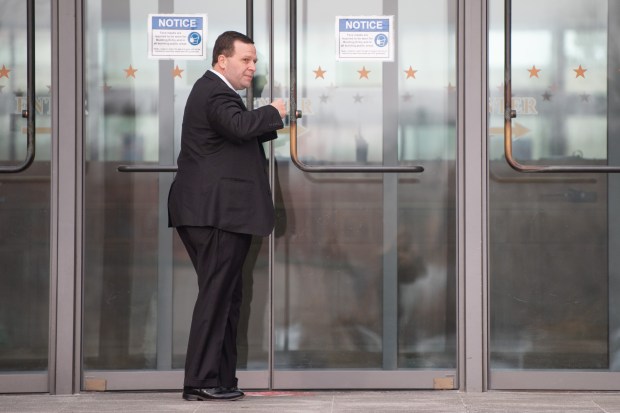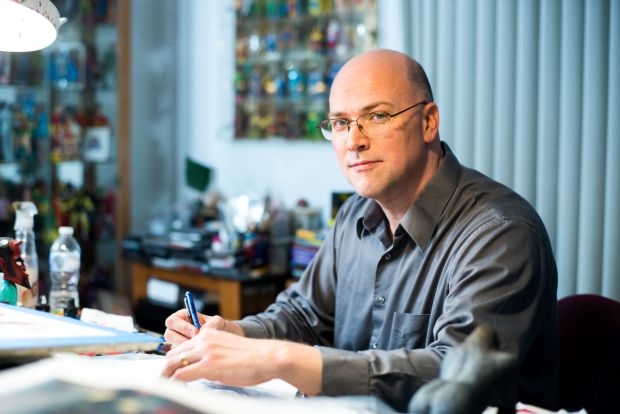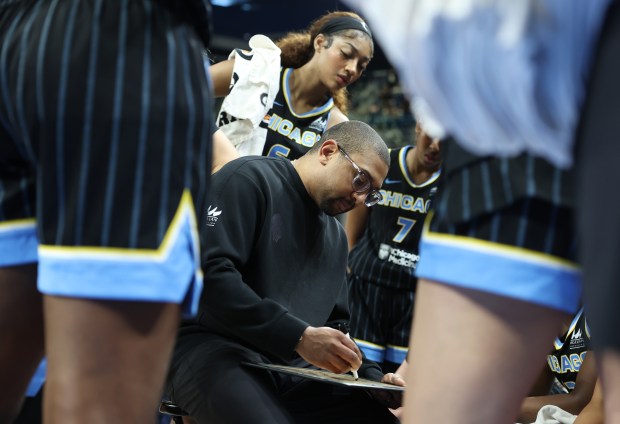Closing arguments in the federal trial of former AT&T Illinois boss Paul La Schiazza, who was accused of bribing House Speaker Michael Madigan, brought an expected crowd to a Chicago courtroom.
But only one spectator could claim to have had a direct influence on the proceedings.
That was James Snyder, the former mayor of Portage, Indiana, whose fight to overturn his own bribery case ended with a U.S. Supreme Court ruling in June that raised the bar for prosecutors in a number of Illinois public corruption cases.
Snyder told the Tribune he was downtown to meet with his appellate lawyer on Tuesday and decided to take in some of the La Schiazza closings. But he was not there two days later, when the case ended dramatically in a mistrial because the jury deadlocked over many of the same issues that were central to his case.
Now, all eyes turn to Madigan’s own trial on racketeering charges, which kicks off in less than three weeks and could pose similar problems for prosecutors, particularly on several counts where they now have to prove there was an agreement with Madigan ahead of time to exchange something of value for an official act.
In its Snyder decision, the high court ruled that “gratuities” – or gifts given as a thank-you for actions a public official has already taken – are not criminalized under the federal statute.
And bribery, the justices made clear, has to involve two parties who, with corrupt intentions, make an explicit agreement to exchange benefits for official action. It requires “the corrupt state of mind and the intent to be influenced in the official act,” the court wrote in the Snyder ruling.
How ominous a sign the La Schiazza mistrial is for the U.S. attorney’s office remains to be seen, but it’s the second post-Snyder public corruption case in a row where prosecutors have failed to win a conviction.
Last month, a jury that was given jury instructions tweaked to satisfy the Snyder ruling acquitted a suburban fencing contractor on charges of bribing Cook County assessor’s office employees with access to an exclusive Michigan golf club in exchange for reduced property tax rates.
That same language was contained in the instructions the La Schiazza jury was given, and is also being proposed by the U.S. attorney’s office for the bribery-related counts in Madigan’s case.
To be sure, every trial is different, and the Madigan and La Schiazza cases in particular are starkly different in scope. While Madigan served as a sort of phantom figure in La Schiazza’s case, his physical presence in court as a defendant will assure all focus is on the former Democratic leader.
But jurors whose comments have found their way into the public sphere said they struggled with the question of intent when it comes to allegations of influencing public officials.
Juror Jocelyn Duran said she came away from the La Schiazza trial having learned a lot about politics and its often-blurred edges. There was not much daylight, she said, between the language of the bribery statute and definition of “lobbying” that jurors were given during the testimony.
“The rules and regulations surrounding lobbyists are not very clear at all, and that fine line between lobbying and bribing or any other kind of illegal act is very hard to determine,” Duran, 29, a market researcher from Chicago, told the Tribune on Thursday evening.
The evidence in La Schiazza’s case took only four days to present and consisted largely of internal AT&T emails and the mostly dry testimony of two insiders, who told the jury about an alleged deal to funnel payments to a longtime Madigan acolyte in exchange for what they believed was the speaker’s support for AT&T’s bill to end mandated landline service.
Madigan’s trial, meanwhile, will feature dozens of wiretapped phone calls, including many between Madigan and his co-defendant, Michael McClain, as well as secretly recorded videos made by a ComEd insider talking about an alleged scheme to secretly pay a cadre of Madigan associates in exchange for his influence over legislation.
And then there’s star prosecution witness Daniel Solis, the former 25th Ward alderman-turned FBI mole who will testify about video recordings he made of Madigan himself allegedly discussing efforts to squeeze a Chinatown developer to hire his private law firm.
But the Snyder ruling could give Madigan’s top-flight legal team new ammunition to counter the sheer volume of evidence, particularly on issues that jurors in La Schiazza’s case struggled over, such as the line where legal lobbying becomes bribery and what constitutes an “exchange” between a politician and those that seek to influence them.
Another juror, a 62-year-old Naperville man, was among several from the panel who stayed behind to talk to lawyers in the case in open court. He told the defense team that their discussions bogged down over whether there had been an “exchange” between La Schiazza and Madigan and if La Schiazza knew that it was improper.
“We really struggled with (La Schiazza’s) intent,” he said, adding that without the defendant taking the witness stand, “We could only deal with what was presented to us.”
La Schiazza, 66, was charged in an indictment returned by a federal grand jury in October 2022 with conspiracy, federal program bribery and using a facility in interstate commerce to promote unlawful activity. The most serious counts carry up to 20 years in prison if convicted.
The charges alleged La Schiazza agreed in 2017 to pay $2,500 a month to retiring state Rep. Eddie Acevedo, Madigan’s onetime assistant majority leader, through the lobbying firm of longtime Madigan political aide Tom Cullen.
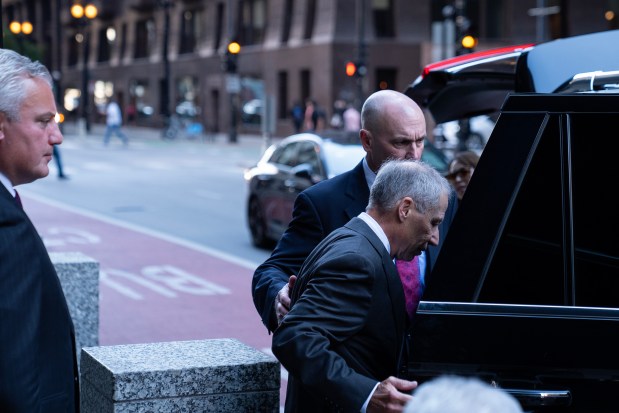
In exchange for the payments, the speaker helped shepherd AT&T’s bill ending mandated landline service, known by the acronym COLR, through the General Assembly, giving La Schiazza a career notch on his belt and saving the telecommunications giant millions of dollars, according to prosecutors.
In her remarks to the Tribune, Duran said though jurors pored over reams of emails, there didn’t seem to be a smoking-gun piece of evidence.
“It’s a bit convoluted to decide based off what we were given,” she said. “We did have to make a lot of inferences, but that’s a valid thing for us to do.”
“You’re giving him all the benefit of the doubt, reasonable doubt,” she said. “But as you start going through things and connecting pieces and making inferences, that kind of reasonable doubt starts running out and eventually got to a point where, for me, there was enough to say one way or the other.”
Duran commended the lawyers, saying both sides’ “speaking skills are great.” And while jurors only considered the evidence that was presented, there were conversations in the room about why certain people weren’t questioned, specifically lobbyists who were working under La Schiazza, she said.
“We only heard from one, (Stephen) Selcke, and he was not even really directly involved in the matter at hand,” she said. “So that was a little confusing.”
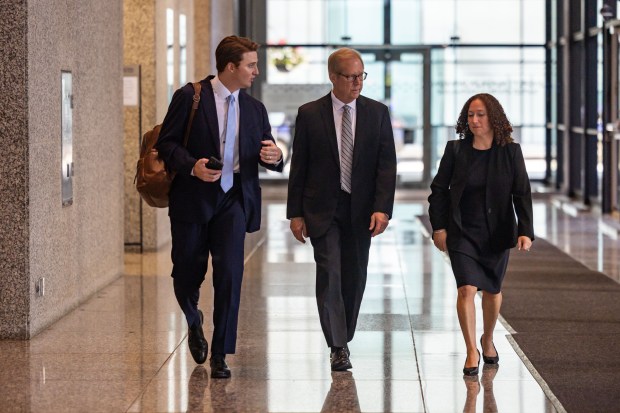
U.S. District Judge Robert Gettleman declared a mistrial Thursday after the jury deadlocked 11-1 in favor of conviction. Before calling the jurors out, the judge told the lawyers that based on volume of the discussions he could hear coming from the jury room, “they were really trying hard.”
Duran told the Tribune that the deliberations were civilized, and that they went back and forth before nearly all had decided there was enough evidence to convict. But one holdout was not convinced, and said there was nothing that could change their mind. Duran did not identify which juror was unswayed.
“We all had a very respectful and great debate, and it is disappointing that we didn’t reach a unanimous decision, but I think we did try,” she said.
Gettleman set a hearing Tuesday to discuss next steps. Any retrial would almost certainly take place after Madigan’s case begins.
Meanwhile, the AT&T evidence will be presented again during Madigan’s trial, but only as one piece of a much broader indictment that accuses the 82-year-old former Democratic heavyweight in a range of schemes to use his official position to bolster his political power and enrich his friends by over more than a decade.
The centerpiece of the case is the allegations involving Commonwealth Edison. According to the charges, McClain conspired with then-ComEd President Anne Pramaggiore and others to funnel $1.3 million in payments to ghost “subcontractors” who were actually Madigan’s 13th Ward cronies.
The utility also hired a clouted law firm run by political operative Victor Reyes, distributed numerous college internships within Madigan’s 13th Ward fiefdom, and blatantly backed former McPier chief Juan Ochoa, the friend of a Madigan ally, for an $80,000-a-year seat on the utility’s board of directors, the indictment alleged.
In return, prosecutors say, Madigan used his influence over the General Assembly to help ComEd score a series of huge legislative victories that not only rescued the company from financial instability but led to record-breaking, billion-dollar profits.
Last year, a separate jury convicted McClain, Pramaggiore, Doherty and former ComEd lobbyist John Hooker on all charges, though that outcome is still being challenged in the wake of the Snyder ruling. Attorneys for the four have claimed a new trial is inevitable.
After those verdicts in May 2023, acting U.S. Attorney Morris “Sonny” Pasqual told reporters that those in business and politics who claim prosecutors have sought to criminalize legal lobbying should seek advice on where the line is.
“This was not the $10,000 in a grocery bag in a back room, it was much more complex and the dollar amounts involved and the gain involved was much more significant as well,” he said. “We’re just gratified that the jury saw it for what it was.”
The jury instructions in La Schiazza’s trial contained several subtle but crucial differences than those given in the ComEd Four case, where prosecutors had to prove only that a defendant “offered to give a thing of value” with the intent to influence or reward a public official in connection with legislative activity.
The La Schiazza jury was instructed there had to be proof of a direct “exchange” for an “official act” — something that the defense homed in on repeatedly in closing arguments.
That language is repeated in the government’s proposed jury instructions in Madigan’s case, which define a bribe as a person who gives something of value “corruptly with the intent to influence or reward an agent of state government in exchange for an official act related to some business, transaction, or series of transactions of the government.”
In his closing argument, La Schiazza’s lead attorney, Tinos Diamantatos, urged the jury to look at the “big picture,” recognizing that AT&T’s COLR relief bill was the culmination of years of legitimate work by the company’s entire government relations staff as well as outside lobbyists, “a team effort by AT&T to get something done lawfully and appropriately.”
If Madigan had truly been bribed and the fix was in, why would La Schiazza have kept pushing so hard? Diamantatos asked. And why would Madigan have kept them guessing by attaching their bill to other legislation that threatened its passage right up to the end?
“You would have to believe that Speaker Madigan, one of the most powerful members in the history of the House, would change his entire position…all because Eddie Acevedo received a nine-month contract for $2,500,” he said.
The argument echoed similar comments from the defense in the ComEd Four case — but that jury didn’t buy it. One ComEd Four juror, Robert Garnes, told the Tribune he and his fellow jurors all felt the defendants “had a chance to stop” the scheme, but chose note to.
“It didn’t have to go this far but it did, because nobody tried to stop it,” Garnes said. “They felt like they were untouchable or just (said) ‘to hell with it.’”
In her remarks, Duran said she knew of Madigan before the trial, but had not “really gotten down into the weeds of it.” But in light of her experience at the Dirksen U.S. Courthouse the past few weeks, she plans to keep tabs on the Madigan trial.
“There were a lot of things I made mental notes on that I want to follow up on, for sure,” she said.
jmeisner@chicagotribune.com


